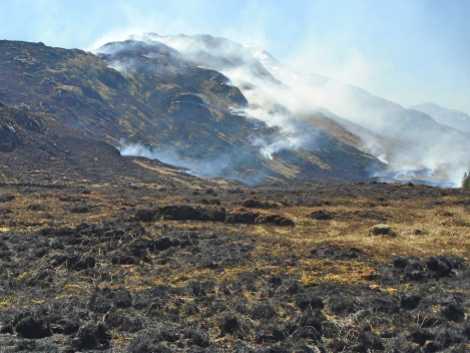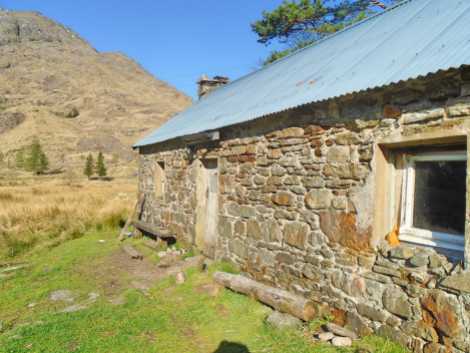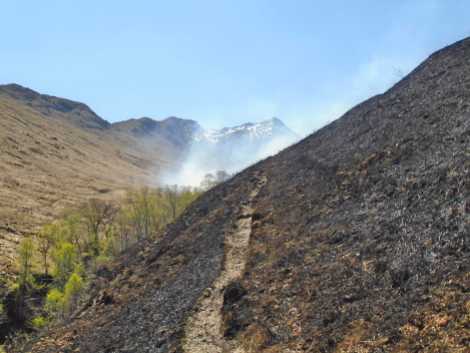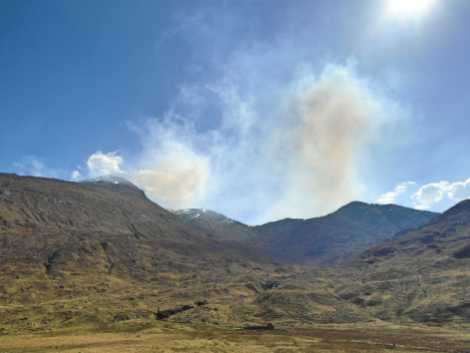
I am following a small path, and reach a point where the glen steepens and narrows. Soon the glen is reduced to steep sided ravine, below me the hillside ends in an abrupt fifty-foot drop into the churning river water. Moments ago, I was in the open glen above, and the smell of smoke seemed a long way off. It was almost comforting, its odour of burning peat reminding me of happy nights beside bothy fires. Now the smoke seems much closer and my eyes are beginning to stream.
I turn a blind corner in the ravine and realise instantly I’m trapped. The fire is sweeping down towards the only path and, in the narrow confines of the gorge, I have nowhere to go. What surprises me is that the fire is burning down towards me. I had always thought that fire burnt up so that I should be quite safe in the valley floor with any fire heading up the slope above me. This fire, oblivious to the laws of physics, is making its way down the hill and heading straight for me. Now it is only a few feet away and about to envelop the path. I need to act fast, I need to move quickly. I need to run, I am certain of that, the only problem is, which way?
I am in the wrong place, and this is the wrong time.

I set off, on an unusually hot day in May, a few hours ago from the tiny Highland village of Glenfinnan. I left the monument http://www.nts.org.uk/Property/Glenfinnan-Monument/, a tall pillar from the top of which an unknown Highlander stands forlornly staring out to sea, scouring the horizon for the return of the Jaccobite prince, behind me. From there I carried on, passing beneath the viaduct made famous by that modern prince, Harry Potter. I had walked out of the shaded forestry, that shrouds the start of the walk, and into the heat of the day where Corryhully bothy sits surrounded by towering hills until finally I crested the high pass on the shoulder of Streap. It was from there I first saw the smoke as a distant plume as I crossed over the pass and backpacked down towards Glen Dessarry http://www.glendessary.info/nesteling, in remote grandeur, at the head of Loch Arkaig. https://en.wikipedia.org/wiki/Loch_Arkaig
‘That smoke is coming right from the place where I am heading,’ I thought, as I sweated under my pack in the unfamiliar heat of early May and a little spark of concern ignited in my brain.
‘I’m on a right of way so public safety will have been considered. Someone is just doing some late muirburning, that fire’ll be managed, it’ll be fine.’
I wonder how many disasters have been preceded by those words?
‘It’ll be fine,’ murmured the captain of the Titanic when he spotted his first ice berg.
‘It’ll be fine!’ Custer called to his men as they marshalled their horses and prepared to ride into the valley of the Little Bighorn.
‘It’ll be fine,’ I tell myself. ‘I’ve been walking these hills for forty years and I’ve never had a problem with fire.’

Walking down the long steep sided glen I had noticed how tinder dry the grass was, seen the smoke turning from grey to a more sinister black, but still I pressed on confident that, on a summer’s day in Scotland, not a great deal could go wrong. I was sure it was muirburning and the thought that this fire might be something a lot more dangerous had never crossed my mind.
In the Scottish Highlands estates often set fire to areas of heather on hillsides in order to burn down old heather and tougher grasses in a practice known as muirburning. This allows new shoots to come through and provides better grazing for sheep and grouse. The fires are well managed but can sometimes get out of control and cause problems. Muirburning normally ceases in mid-April and, despite the fact that this was early May, I was still convinced that the smoke I could see was just the farmer managing his grazing.
Meeting the fire face to face in the ravine very quickly convinced me otherwise. Despite the fact the flames were only a couple of feet high, close up the heat was intense. I could see the fire making for the path I had to cross but I was confident I could get to the path before the flames.

I was wrong. The fire was moving much faster than I realised and got to the path I needed to cross at exactly the same time as me. I hesitated for a moment, I didn’t know if the fire had closed off the path behind me and, in the billowing smoke, I couldn’t be sure if the path ahead was also engulfed. The only thing I was certain of was that remaining where I was, for more than a few seconds, was not an option.
I decided to make a break for path ahead. As I tried to move forward the flames rose up and pushed me off the path and towards the vertical drop into the gorge below, instantly impressing upon me the seriousness of the situation. I spent a moment clinging to the steep grass, uncertain of what to do. Momentarily the flames parted and I could see a clear route out and on to the path beyond the fire. Normally I am not the most athletic of folk, I’m more your solid plodding type than an agile mountain goat. Under normal circumstances I move even less gracefully when weighed down by a rucksack full of three day’s food and my cooking and sleeping gear. Over the next few seconds, however, I was imbued with an athletic ability that would be the envy of an Olympic gymnast. I flowed gracefully over the ground with the urgency of a gazelle being chased by lions. The only difference between me and the gazelle was that my lions had tongues of flame and, as far as I know, gazelles don’t swear as loudly as I did.
After about twenty yards I emerged unscathed from the burning bush and found, much to my relief, that the fire had already passed over the path below me and the rest of the way appeared safe. At this point a braver man than me would have turned a photographed the fire I had just passed through. Unfortunately, I didn’t have a braver man with me at that moment and my top priority was to get out of there as fast as my wobbling legs would carry me.
Down in the glen, safely away from the flames, I was at last able to drop my pack and gather my wits. Standing beside the river I noticed the remains of a campfire at the lowest edge of the burnt grass. This fire was almost certainly the cause of the conflagration. Looking back up the hillside it appeared as though half the mountain was now consumed in billowing smoke.

That evening I sat outside Glen Pean bothy and watched as smoke billowed hundreds of feet into the cloudless sky. The culprits, who had carelessly let a spark from their fire to set alight the whole mountain, had long fled. Over the next two days, fanned by strong easterly winds and fuelled by exceptionally hot May weather, the fire ranged across the mountainside eventually consuming hundreds acres for a distance of at least five miles. Eventually it burnt itself out after three days.
Two days later I retraced my steps over the burnt ground heading back to Glenfinnan. On my way I met over a dozen folk, all following my charred route on their way to complete the Cape Wrath Trail. I’d been lucky, I’d found my way through the fire but if they had made that journey two days earlier there’s a possibility they might not all have been so fortunate.

So can you out run a wildfire? I don’t know but I can promise you this…you can move much faster than you think.
I’m sorry John but I laughed all the way through that one – I wouldn’t have laughed if it had been me though, I’m terrified of fire! The smoke must have been awful too. I’d hate to have to run around with a camping pack on too! Glad you survived!
Carol.
Thanks very much for those kind words